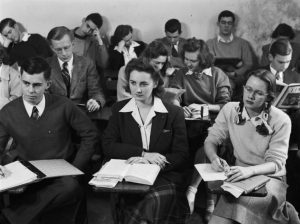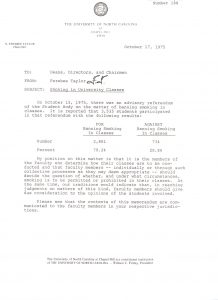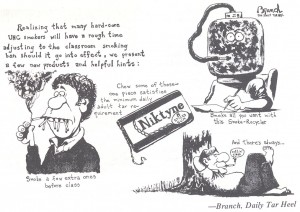
On today’s campus, where smoking is not permitted inside or within 100 feet of any university buildings, it may be hard for students to imagine that a little less than 40 years ago, many students and faculty smoked during class.
Prior to 1975, some departments and individual faculty members had barred smoking in their classes, but the rules were not always enforced. One student, writing to Chancellor Ferebee Taylor, complained that he “[had] one class with four ‘no smoking’ signs posted in it” but “the professor continually ignored the enforcement of these signs while students continue[d] to smoke.” He also described attending a program in Memorial Hall where despite “no smoking” signs, dozens of students smoked, “leaving many in a cloud.”
In March 1975, students from the School of Public Health began pushing for a ban on all smoking in classrooms, citing the unpleasant environment it created for nonsmokers as well as growing evidence that “passive smoking” (second-hand smoke) was a health hazard. NC State and Appalachian State already had policies banning smoking in classrooms, and students had successfully lobbied for a smoking ban in the UNC School of Public Health.

John Sawyer, a student at the School of Public Health and a member of the Campus Governing Council (CGC), wrote to Chancellor Taylor asking for his support and proposed to the CGC that the issue be put to a student vote the following fall. Randall Thomas, another student in the School of Public Health and the chair of the Campus Committee to Ban Classroom Smoking, joined Sawyer in meeting with Chancellor Taylor in April. The Chancellor indicated in the meeting and in subsequent correspondence that he felt it was an issue best left to the faculty, as it affected their classrooms, but that the faculty should consider student opinion. Some criticized Taylor for not explicitly supporting the ban, but students focused their efforts on gaining faculty support.
In the days leading up to the referendum vote, the Daily Tar Heel encouraged students to vote in favor of the proposed ban. In an editorial, a student explained: “We do not dispute the rights of smokers to consume tobacco and the pollutants it contains [. . .] However, that right ends at the end of the other people’s noses, veins, and lungs.” The newspaper explained that while there was not enough data at the time to prove that “passive smoking” (second-hand smoke) was dangerous, being exposed to smoke in enclosed classrooms was at the very least an annoyance to nonsmokers.

On October 15, 3,535 students voted, and 2,801 (80%) supported the ban. Students then petitioned the Faculty Council to vote on the issue. Two plans were proposed to the Faculty Council: one completely banning smoking in classrooms, and one calling for individual classes to decide whether or not smoking would be allowed in the class that semester. When the faculty met on November 24, the first proposal passed overwhelmingly, banning all smoking in classrooms.
